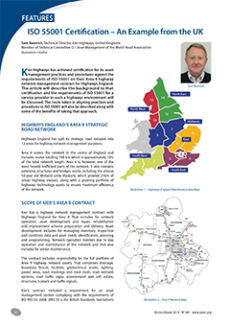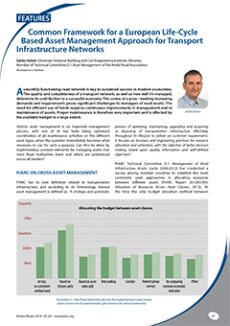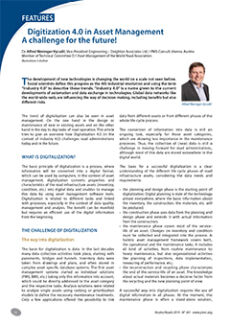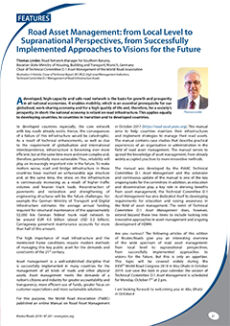Publications Routes/Road Road assets management
This page lists Routes/Roads articles of PIARC in the field of road assets management. These publications are classified chronologically.
-
Requirements for the Education of Road Asset Managers - A PIARC Approach*

Asset Management is a relatively new discipline. It was only established at the beginning of this century. However, the foundations were laid as early as the 1980s and 1990s. They were the result of the efforts of experts from several countries and disciplines to develop a common concept and language with the aim of supporting organizations to creating value from the available asset.
-
ISO 55001 Certification - An example from the UK*

The article will describe the background to that certification and the requirements of ISO 55001 for a service provider in such a highways environment will be discussed. The route taken in aligning practices and procedures to ISO 55001 will also be described along with some of the benefits of taking that approach.
-
Common Framework for a European Life-Cycle Based Asset Management Approach for Transport Infrastructure Networks

This article describes the framework as proposed and shows how it enables transport managers to perform activities not only cross assets but also cross modes and across borders.
-
Digitalization 4.0 in Asset Management - A challenge for the future!

This article tries to give an overview on how Digitalization 4.0 (in the context of Industry 4.0) challenges road administrations today and in the future.
-
Road Asset Management: from Local Level to Supranational Perspectives, from Successfully Implemented Approaches to Visions for the Future

A developed, high-capacity and safe road network is the basis for growth and prosperity in all national economies. It enables mobility, which is an essential prerequisite for our globalised, work-sharing economy and for a high quality of life and, therefore, for a society’s prosperity. In short: the national economy is reliant on road infrastructure. This applies equally to developing countries, to countries in transition and to developed countries.